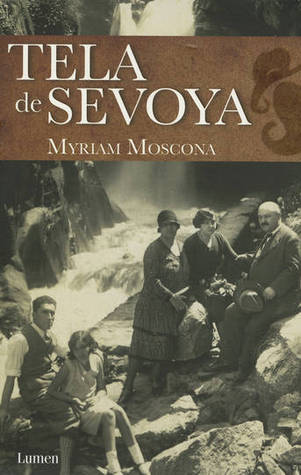Myriam Moscona
TELA DE SEVOYA
Barcelona: Acantilado, 2014. ISBN: 978-8426422873
Reviewed by Regina Igel1
Ladino is one of the most enigmatic and most transparent of the idioms. However, it is an enigma clearly understood by those who know its history. It was born by the end of the fifteenth century, around 1492, when the expulsion of Jews from Spain was officially decreed. The only “thing” they were able to take with them was their language, Ladino or judeo-español (among other names given the language). Many subsequent generations kept the language alive as one of their means of oral communication at home, in commerce, in travels, also in writing of family letters, cards, and so forth. Time and the continuous spread of the Sephardic communities took their toll on the practice of Ladino and the language became more and more restricted to only a few people along the centuries. Some families kept Ladino alive in their conversations and written communication, well in the twentieth century. That is when we come to the Latin American author, Myriam Moscona, a Sephardic Jew from Mexico, descendant of Bulgarian and Turkish Jews, who inherited the language from her relatives. Moscona is a journalist, translator, and poet. She is well-known from previous works of literature and journalism, and has shown the world that it is possible to publish in Ladino, with a book of poetry (Ansina) and texts in judeo-español distributed in other literary works, along with the book being reviewed. Tela de sevoya received the Xavier Villaurrutia Award in 2012, one of the most coveted literary prizes in Mexico.
As it can be noticed, the title of this book is in Ladino. “Tela” refers to the several layers covering the “sevoya” (cebolla in Spanish, onion in English). Once we start reading it, we appreciate that the metaphor suggests the detaching of numerous coatings of memories regarding her childhood, some members of her family, places visited, in a quest to discover the passions that moved the generations that preceded her, how life was in Bulgaria before the Holocaust, along with specific portrayals of people she knew or about whom she heard stories.
The narrator’s reminiscences are distributed through an unconventional structure, as if her memories were plucked at random, in alternative chapters: “Distancia de foco” (Focus distance), “Molino de viento” (Windmill), “Del diario de viaje” (From the travel log), “Pisapapeles” (Paperweight), “Kantikas” (Poems), and “La cuarta pared” (The fourth wall). In the sharing of recollections and observations, the narratives lean on two areas: first are the traumatic remembrances from the times she lived in the same house with two widows, her mother and her maternal grandmother, the latter being nothing less than a wicked grandma, followed by the search for her antecedents, which includes visiting places where they lived in Bulgaria and other locale, their occupations, and so forth.
The pieces exposed in the flow of the narrator’s pursuits of the past include her dreams, visions, and conversations with the dead; surrealistic images of people disclosing messages regarding life and death, along with songs in Ladino, texts as essays either explaining the origin and the development of Ladino including its several names etc.; or the destinies of relatives, including descriptions of happy encounters during her travels with the goal of which was to seek out the roots, habits, language of her family before she was born.
Victoria, her maternal grandmother, was a “sinister woman” in the narrator’s words. A bitter and cruel woman, she mistreated her grandchild, as she had ill-treated her own children while living in Bulgaria, like making the pet they loved very much disappear, for example. The grandchild had to tolerate the old woman’s insults, threats, and a series of abuses that deeply affected her for life. Yet, the scene of their last encounter, Victoria in her death-bed, still an old, dreadful woman, remained in the narrator’s memory. The child asked for forgiveness, for always confronting the grandma, in Spanish, the language used when addressing her: “Abuela, me perdonas?” to which request the grandma answers, in Ladino: “No. Para una preta kriatura komo sos, no ai pedron.” (“Grandma, do you pardon me?” “No, for a bad girl like you, there is no pardon.”) The girl kept the last sentence issued by Victoria in the depth of her mind, keeping it for life.
Other memories, some happier that the latter, fill the narratives, being “Distancia de foco” the section devoted to discuss many aspects of her family’s life before she was born and also in Mexico, where she lived with her mother, an opera singer and piano performer.
Tela de sevoya, a novel developed through reminiscences, echoes the influence of Marcel Proust, in the author’s own words expressed in the publication. Besides short chronicles in Spanish and Ladino, it gathers recipes (one of them concocted by a “new-Christian” at the service of King Fernando I, the executioner of Jews and Moslems), jokes (including Jews as characters), and Ladino proverbs. It is a book that uncovers many layers of the Sephardic communities linked by Ladino and also a live representation of a language that can be regarded as resistant against times, like the Jews that spoke it.
1 Regina Igel is Professor Emerita of Spanish and Portuguese at the University of Maryland.

